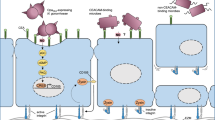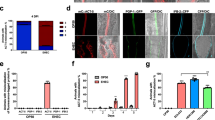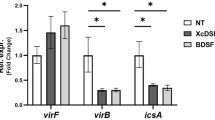Abstract
Shigella flexneri, the causative agent of bacillar dystentery, invades the colonic mucosa where it elicits an intense inflammatory reaction responsible for destruction of the epithelium1,2. During cell invasion, contact with host cells activates the type-III secretion of the Shigella IpaB and IpaC proteins3,4. IpaB and IpaC are inserted into host cell plasma membranes and trigger initial signals that result in actin polymerization, while allowing cytosolic access of other bacterial effectors that further reorganize the cytoskeleton5,6. After internalization, Shigella moves intracellularly and forms protrusions that infect neighbouring cells, promoting bacterial dissemination across the epithelium2,6. Here, we show that during cell invasion, Shigella induces transient peaks in intracellular calcium concentration that are dependent on a functional type-III secretory apparatus. In addition, Shigella invasion induces the opening of Connexin 26 (Cx26) hemichannels in an actin- and phospholipase-C-dependent manner, allowing release of ATP into the medium. The released ATP, in turn, increases bacterial invasion and spreading, as well as calcium signalling induced by Shigella. These results provide evidence that pathogen-induced opening of connexin channels promotes signalling events that favour bacterial invasion and dissemination.
This is a preview of subscription content, access via your institution
Access options
Subscribe to this journal
Receive 12 print issues and online access
$209.00 per year
only $17.42 per issue
Buy this article
- Purchase on Springer Link
- Instant access to full article PDF
Prices may be subject to local taxes which are calculated during checkout





Similar content being viewed by others
References
Labrec, E.H., Schneider, H., Magnani, T.J. & Formal, S.B. Epithelial cell penetration as an essential step in the pathogenesis of bacillary dysentery. Infect. Immunol. 88, 1503–1518 (1964).
Sansonetti, P. Molecular and cellular mechanisms of invasion of the intestinal barrier by enteric pathogens. The paradigm of Shigella. Folia Microbiol. 43, 239–246 (1998).
Parsot, C. et al. Enhanced secretion through the Shigella flexneri Mxi-Spa translocon leads to assembly of extracellular proteins into macromolecular structures. Mol. Microbiol. 16, 291–300 (1995).
Hueck, C.J. Type III secretion systems in bacterial pathogens of animals and plants. Microbiol. Mol. Biol. Rev. 62, 379–433 (1998).
Tran Van Nhieu, G. et al. Bacterial signals and cell responses during Shigella entry into epithelial cells. Cell. Microbiol. 2, 187–193 (2000).
Suzuki, T. & Sasakawa, C. Molecular basis of the intracellular spreading of Shigella. Infect. Immun. 69, 5959–5966 (2001).
Schuch, R., Sandlin, R.C. & Maurelli, A.T. A system for identifying post-invasion functions of invasion genes: requirements for the Mxi–Spa type III secretion pathway of Shigella flexneri in intercellular dissemination. Mol. Microbiol. 34, 675–689 (1999).
Rathmann, M. et al. The development of a FACS-based strategy for the isolation of Shigella flexneri mutants that are deficient for intercellular spread. Mol. Microbiol. 35, 974–990 (2000).
Sansonetti, P.J. et al. Cadherin expression is required for the spread of Shigella flexneri between epithelial cells. Cell 76, 829–839 (1994).
Manthey, D. & Willecke, K. Transfection and expression of exogenous connexins in mammalian cells. Methods Mol. Biol. 154, 187–199 (2001).
Bruzzone, R., White, T.W. & Paul, D.L. . Connections with connexins: the molecular basis of direct intercellular signaling. Eur. J. Biochem. 238, 1–27 (1996).
Willecke, K. et al. Structural and functional diversity of connexin genes in the mouse and human genome. Biol. Chem. 383, 725–737 (2002).
Mesnil, M. et al. Bystander killing of cancer cells by herpes simplex virus thymidine kinase gene is mediated by connexins. Proc. Natl Acad. Sci. USA 93, 1831–1835 (1996).
Goldberg, G.S. et al. Evidence that disruption of connexon particle arrangements in gap junction plaques is associated with inhibition of gap junctional communication by a glycyrrhetinic acid derivative. Exp. Cell Res. 222, 48–53 (1996).
Boitano, S., Dirksen, E.R. & Sanderson, M.J. Intercellular propagation of calcium waves mediated by inositol trisphosphate. Science 258, 292–295 (1992).
Clair, C. et al. Investigation of the roles of Ca2+ and InsP3 diffusion in the coordination of Ca2+ signals between connected hepatocytes. J. Cell Sci. 114, 1999–2007 (2001).
Quist, A.P. et al. Physiological role of gap-junctional hemichannels. Extracellular calcium-dependent isoosmotic volume regulation. J. Cell Biol. 148, 1063–1074 (2000).
Contreras, J.E. et al. Metabolic inhibition induces opening of unapposed connexin 43 gap junction hemichannels and reduces gap junctional communication in cortical astrocytes in culture. Proc. Natl Acad. Sci. USA 99, 495–500 (2002).
Muller, D.J., Hand, G.M., Engel, A. & Sosinsky, G.E. Conformational changes in surface structures of isolated connexin 26 gap junctions. EMBO J. 21, 3598–3607 (2002).
Stout, C.E., Constantin, J.L., Naus, C.C. & Charles, A.C. Intercellular calcium signaling in astrocytes via ATP release through connexin hemichannels. J. Biol. Chem. 277, 10482–10488 (2002).
Cotrina, M.L. et al. Connexins regulate calcium signaling by controlling ATP release. Proc. Natl Acad. Sci. USA 95, 15735–15740 (1998).
Guthrie, P.B. et al. ATP Released from Astrocytes Mediates Glial Calcium Waves. J. Neurosci. 19, 520–528 (1999).
Voogd, T.E., Vansterkenburg, E.L.M., Wilting, J. & Janssen, H.M. Recent research on the biological activity of suramin. Pharmacol. Rev. 45, 177–203 (1993).
Uhlen, P. et al. α-hemolysin of uropathogenic E.coli induces Ca2+ oscillations in renal epithelial cells. Nature 405, 694–697 (2000).
Dolmetsch, R.E. et al. Differential activation of transcription factors induced by Ca2+ response amplitude and duration. Nature 386, 855–858 (1997).
Gewirtz, A.T. et al. Salmonella typhimurium induces epithelial IL-8 expression via Ca2+-mediated activation of the NF-kB pathway. J. Clin. Invest. 105, 79–92 (2000).
Chantret, I., et al. Differential expression of sucrase-isomaltase in clones isolated from early and late passages of the cell line Caco-2: evidence for glucose-dependent negative regulation. J. Cell Sci. 107, 213–225 (1994).
Garcia, M.-I. et al. The afimbrial adhesive sheath encoded by the afa-3 gene cluster of pathogenic E. coli is composed of two adhesins. Mol. Microbiol. 19, 683–693 (1996).
Oaks, E.V., Wingfield, M.E. & Formal, S.B. Plaque formation by virulent Shigella flexneri. Infect. Immun. 48, 124–129 (1985).
Bootman, M.D. et al. Smoothly graded Ca2+ release from inositol 1,4,5-trisphosphate-sensitive Ca2+ stores. J. Biol. Chem. 269, 24783–24791 (1994).
Acknowledgements
The authors wish to thank H. Yamasaki for his interest in this study. We thank L. Venance for helpful suggestions on the carbenoxolone experiments. P.S. is a Howard Hughes Medical Institute Scholar. This work was supported in part by a grant from the Programme de Recherche Fondamentale en Microbiologie Maladies Infectieuses et Parasitaires from the Ministère de la Recherche et de la Technologie and a Programme Transversal de Recherches (PTR no 54) from the Institut Pasteur to G.T.V.N.
Author information
Authors and Affiliations
Corresponding author
Ethics declarations
Competing interests
The authors declare no competing financial interests.
Supplementary information
Rights and permissions
About this article
Cite this article
Van Nhieu, G., Clair, C., Bruzzone, R. et al. Connexin-dependent inter-cellular communication increases invasion and dissemination of Shigella in epithelial cells. Nat Cell Biol 5, 720–726 (2003). https://doi.org/10.1038/ncb1021
Received:
Accepted:
Published:
Issue Date:
DOI: https://doi.org/10.1038/ncb1021
This article is cited by
-
Acoustofluidic waveguides for localized control of acoustic wavefront in microfluidics
Microfluidics and Nanofluidics (2017)
-
Roles of connexins and pannexins in digestive homeostasis
Cellular and Molecular Life Sciences (2015)
-
Actin-based confinement of calcium responses during Shigella invasion
Nature Communications (2013)
-
Adenosine‐A3 receptors in neutrophil microdomains promote the formation of bacteria‐tethering cytonemes
EMBO reports (2013)
-
Connexin 26 facilitates gastrointestinal bacterial infection in vitro
Cell and Tissue Research (2013)



